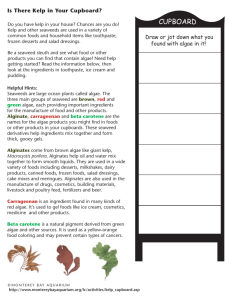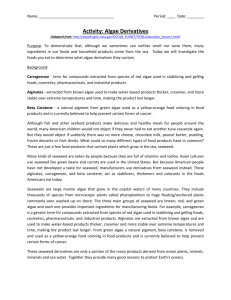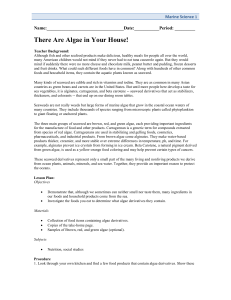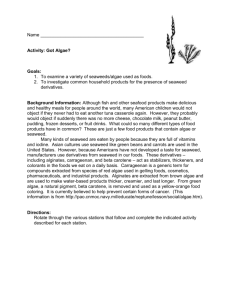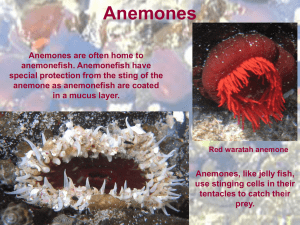There Are Algae in Your House
advertisement
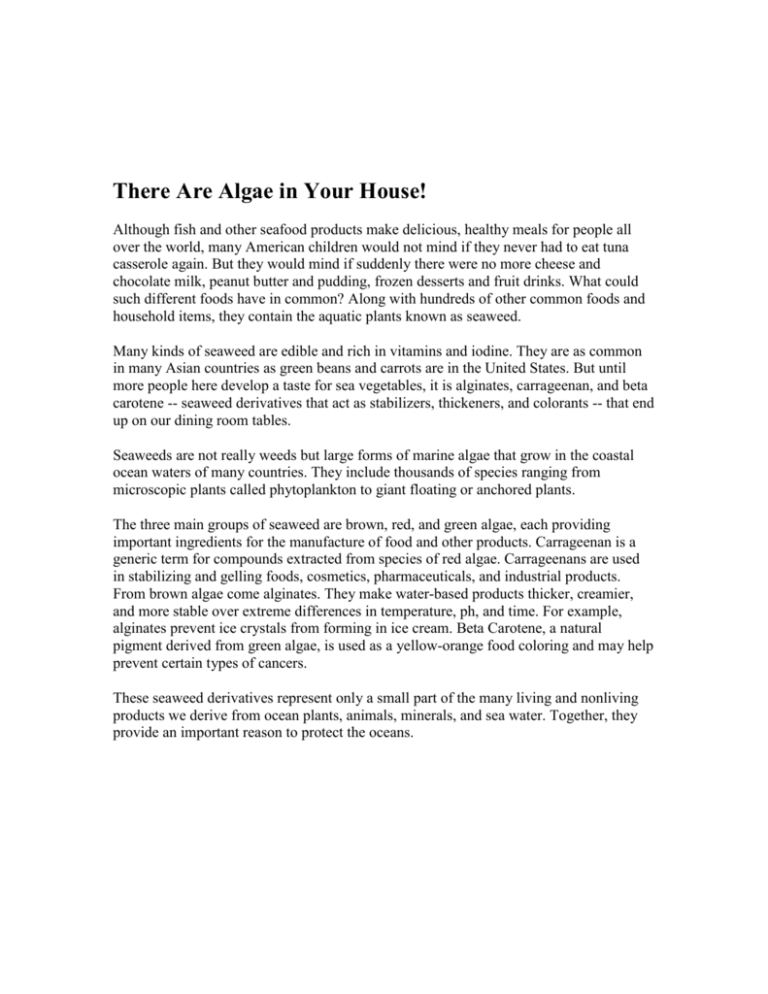
There Are Algae in Your House! Although fish and other seafood products make delicious, healthy meals for people all over the world, many American children would not mind if they never had to eat tuna casserole again. But they would mind if suddenly there were no more cheese and chocolate milk, peanut butter and pudding, frozen desserts and fruit drinks. What could such different foods have in common? Along with hundreds of other common foods and household items, they contain the aquatic plants known as seaweed. Many kinds of seaweed are edible and rich in vitamins and iodine. They are as common in many Asian countries as green beans and carrots are in the United States. But until more people here develop a taste for sea vegetables, it is alginates, carrageenan, and beta carotene -- seaweed derivatives that act as stabilizers, thickeners, and colorants -- that end up on our dining room tables. Seaweeds are not really weeds but large forms of marine algae that grow in the coastal ocean waters of many countries. They include thousands of species ranging from microscopic plants called phytoplankton to giant floating or anchored plants. The three main groups of seaweed are brown, red, and green algae, each providing important ingredients for the manufacture of food and other products. Carrageenan is a generic term for compounds extracted from species of red algae. Carrageenans are used in stabilizing and gelling foods, cosmetics, pharmaceuticals, and industrial products. From brown algae come alginates. They make water-based products thicker, creamier, and more stable over extreme differences in temperature, ph, and time. For example, alginates prevent ice crystals from forming in ice cream. Beta Carotene, a natural pigment derived from green algae, is used as a yellow-orange food coloring and may help prevent certain types of cancers. These seaweed derivatives represent only a small part of the many living and nonliving products we derive from ocean plants, animals, minerals, and sea water. Together, they provide an important reason to protect the oceans. Lesson Plan: Objectives Demonstrate that, although we sometimes can neither smell nor taste them, many ingredients in our foods and household products come from the sea. Investigate the foods you eat to determine what algae derivatives they contain. Materials Collection of food items containing algae derivatives. Copies of the take-home page. Samples of Brown, red, and green algae (optional). Subjects Nutrition, social studies Procedure 1. Look through your own kitchen and find a few food products that contain algae derivatives. Show these items to your class, without mentioning that they come at least partially from the sea. Ask students to guess what the foods have in common. 2. Explain that each product contains algae in the form of seaweed, which is now used in many everyday foods and household items. Hold up one of the products that you brought in and show the students where they can find the nutrition label on the packaging. Show students pictures or samples of brown, red, and green algae, from which ingredients in the foods on display are derived. To find these different types of seaweed, check an Asian supermarket or specialty food store. 3. Ask if any of the groups found information on all of the foods listed on the take-home page. Do any of the foods contain two or more of the algae derivatives? 4. Have students consider whether they would eat the whole seaweed plant, knowing now that they already eat algae extracts in many foods. Offer samples of dried, edible seaweed (nori, kombu, dulse, kelp), if available, for students to smell and taste. Explain that algae are rich in vitamins and iodine and, in Asian cultures especially, are used as a wrapping to hold together rice, meat, and vegetables (for example, in sushi). Ask students what food they use to hold these ingredients together. What makes bread so much more readily available in the United States than in Japan and other Asian countries? Take-Home Worksheet: Look for the following ingredients, which come from seaweed, in the foods you have in your house: carrageenan, alginates, beta carotene. Place a check mark in the appropriate box to indicate which of these ingredients are listed in each food's label. There may be more than one per food. Teacher Key: !-carrageenan @-alginate #-beta carotene Product Containing Algae ! @ # Brownie mix ! @ Cheese (yellow and orange) # Chocolate milk ! Coffee creamer ! # Cottage cheese ! Egg substitute # Evaporated milk ! Frozen foods and desserts @ # Frozen yogurt ! Ice cream ! # Infant formula ! Margarine # Mayonnaise # Multiple vitamins # Pet food ! Pudding (cooked) ! Relishes ! @ Salad dressing @ # Sauces and gravies ! @ Sour cream ! Toothpaste ! Whipped topping ! # Whipping cream ! Yogurt ! Written by: Beth Nalker (bjn@ic.si.edu) Environmental Awareness Program, Smithsonian Institution Doug Casey (eseem005@sivm.si.edu), Office of Elementary and Secondary Education, Smithsonian Insitution). Ocean Planet Exhibition Floorplan gene carl feldman (gene@seawifs.gsfc.nasa.gov) (301) 286-9428 Judith Gradwohl, Smithsonian Institution (Curator/Ocean Planet)
